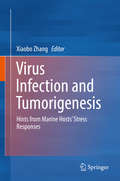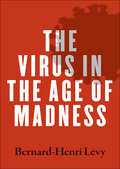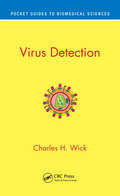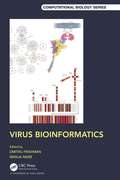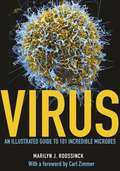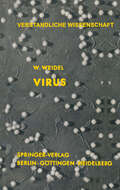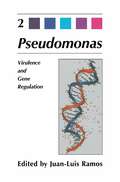- Table View
- List View
Virus-Like Particles: A Comprehensive Guide
by Paul Pumpens Peter PushkoThis book represents the first complete and systematic guide to the virus-like particles (VLPs) and their applications as vaccines, therapeutic tools, nanomaterials, and nanodevices. The grouping of the VLPs follows the most recent virus taxonomy and the traditional Baltimore classification of viruses, which are based on the genome structure and mechanism of mRNA synthesis. Within each of the seven Baltimore classes, the order taxon serves as a framework of the chapter’s arrangement. The term "VLP" is used as a universal designation for the virus-, core-, or capsid-like structures, which became an important part of the modern molecular virology. The 3D structures, expression systems, and nanotechnological applications are described for VLPs in the context of the original viruses and uncover their evolving potential as novel vaccines and medical interventions. Key Features Presents the first full guide to the VLP nanotechnology, classified by current viral taxonomy Outlines specific structural properties and interconnection of the virions and VLPs Explains generation and characteristics of VLPs produced by various expression systems Offers up-to-date summary of VLPs designed as vaccines and delivery tools Unveils interconnection of VLPs with novel organic and inorganic nanomaterials
Virus-Like Particles: A Comprehensive Guide
by Paul Pumpens Peter PushkoThis book represents the first complete and systematic guide to the virus-like particles (VLPs) and their applications as vaccines, therapeutic tools, nanomaterials, and nanodevices. The grouping of the VLPs follows the most recent virus taxonomy and the traditional Baltimore classification of viruses, which are based on the genome structure and mechanism of mRNA synthesis. Within each of the seven Baltimore classes, the order taxon serves as a framework of the chapter’s arrangement. The term "VLP" is used as a universal designation for the virus-, core-, or capsid-like structures, which became an important part of the modern molecular virology. The 3D structures, expression systems, and nanotechnological applications are described for VLPs in the context of the original viruses and uncover their evolving potential as novel vaccines and medical interventions. Key Features Presents the first full guide to the VLP nanotechnology, classified by current viral taxonomy Outlines specific structural properties and interconnection of the virions and VLPs Explains generation and characteristics of VLPs produced by various expression systems Offers up-to-date summary of VLPs designed as vaccines and delivery tools Unveils interconnection of VLPs with novel organic and inorganic nanomaterials
Virus Infections and Diabetes Mellitus (Developments in Medical Virology #2)
by Yechiel BeckerThis volume in the series Developments in Medical Virology deals with viruses involved in diabetes mellitus, a syndrome with a strong genetic background that causes damage to the regulation of insulin synthesis and function. Viruses were found either to cause or to stimulate diabetes mellitus in man and in animal models. The nature of the role of viruses is described by many of the scientists who participated in the original studies. To complete the picture, chapters were included that deal with the insulin gene, the secondary structure of the proinsulin and insulin receptor polypeptides, pancreatic Langerhans islets, and clinical considerations of the disease. The aim of Developments in Medical Virology is to elucidate processes involving viruses as pathogens of cells and organisms, with special attention to human diseases. A number of volumes will be devoted to viruses affecting specific organs (e.g. brain, liver, etc.), while others will elaborate on the clinical experience in the use of antiviral drugs. The series is published in parallel with Developments in Molecular Virology, designed to present an analysis of molecular mechanisms implicated in virus infection and replicative processes. In addition, the series Developments in Veterinary Virology provides information on viruses causing diseases in animals, with special emphasis on aspects of interest to veterinarians.
Virus Infection and Tumorigenesis: Hints from Marine Hosts’ Stress Responses
by Xiaobo ZhangThis book reviews the latest research on the molecules and mechanisms of marine host stress responses to viral infections and tumorigenesis. It offers an overview of the state of the art in the field as well as future directions. Metabolism disorder is a characteristic of tumorigenesis. Since viruses complete their life cycle in host cells, such infections cause metabolic disorders in the host. As such, the mechanisms of virus pathogenesis and tumor progression are similar or even identical. In essence, the role of antiviral molecules is to maintain the metabolic homeostasis of infected host cells, and the antiviral molecules induced by virus infection may play an important role in antitumor pathways, resulting in cancer cell death or restoring the disordered metabolism of cancer cells. The molecules generated during host stress responses to viruses can also contribute to the antitumor mechanisms in humans. However, the relationship between host stress responses to virus infection and tumorigenesis has not been extensively explored. In recent years, studies have shown that marine host stress responses to viral invasion can be good models for exploring human antitumor mechanisms. Stimulating further research in the field, this book offers graduate students and researchers with comprehensive insights into host stress responses to viral invasion and tumor progression. It is also a valuable resource for those working in the pharmaceutical industry interested in drug discovery based on molecules derived from host stress responses to viral infection.
Virus Infected Cells (Subcellular Biochemistry #106)
by Swetha Vijayakrishnan Yaming Jiu J. Robin HarrisVirus-infected Cells is a comprehensive and technical exploration of the intricate interactions between viruses and host cells. This book delves into the molecular and cellular aspects of viral infections, providing a wealth of knowledge about various viruses and their effects on cellular mechanisms. The first part of the book covers general/technical aspects, introducing the reader to the field of virology and providing an overview of the techniques used to study virus-infected cells. It covers topics such as the visualisation of virus-infected cells by cryo-electron tomography and the assessment of necroptosis, a type of programmed cell death, in virus-infected cells. In addition, the book explores the role of apoptosis and phagocytosis as antiviral mechanisms, as well as the intricate process of viral membrane fusion and penetration. It also discusses the tracking of viral entry into living cells and the use of correlative cryo-imaging to study the biology of viruses in cells and tissues. Finally, the book examines the cytopathic effect induced by viruses, shedding light on the damage caused to infected cells. The second section of the book explores specific viruses and their interactions with host cells. Each chapter focuses on a specific virus and provides an in-depth look at its behaviour within infected cells. The book covers a wide range of viruses, including human papillomavirus, respiratory syncytial virus, Japanese encephalitis virus, African swine fever virus, coronavirus, influenza A virus and human endogenous retroviruses. Each chapter examines unique aspects of virus-host interactions, such as viral assembly, impact on the cytoskeleton, critical host-virus interactions mediated by viral RNA, mechanisms of cell entry, and the involvement of cholesterol in virus budding and scission. This volume in the Subcellular Biochemistry series is a valuable resource for researchers, virologists and students interested in understanding the complex dynamics between viruses and the cells they infect. With its detailed exploration of general and specific aspects of virus-host interactions, this book provides a comprehensive understanding of the molecular and cellular mechanisms involved in viral infections.
Virus-Induced Immunosuppression (Infectious Agents and Pathogenesis)
by Steven Specter Mauro Bendinelli Herman FriedmanIt is now widely acknowledged that at the beginning of this century Claude von Pirquet first pointed out that a viral disease, i. e. , measles, resulted in an anergy or depression of preexisting immune response, namely, delayed continuous hypersensitivity to PPD derived from Mycobacterium tuberculosis. Thereafter ob servations that viral infections may result in immunosuppression have been recorded by many clinicians and infectious disease investigators for six or seven decades. Nevertheless, despite sporadic reports that infectious diseases caused by viruses may result in either transient or prolonged immunodepression, investigation of this phenomenon languished until the mid-1960s, when it was pointed out that a number of experimental retroviral infections of mice with tumor viruses may result in marked immunosuppression. However, it was not until the recognition of the new epidemic of acquired immunodeficiency syn drome (AIDS) caused by the human immunodeficiency virus and related vi ruses that acquired immunodeficiencies associated with virus infection became general knowledge among biomedical investigators as well as the lay public. A number of reviews published during the past decade or so pointed out that numerous viruses may affect humoral and cellular immune responses. Furthermore, expanding knowledge about the nature and mechanisms of both humoral and cellular immunity and pathogenesis of viral infections has pro vided clinical and experimental models for investigating in depth how and why viruses of man and animals profoundly affect immune responses.
Virus-Induced Gene Silencing: Methods and Protocols (Methods in Molecular Biology #975)
by Annette BeckerPlants are amazing organisms to study, some are important sources for pharmaceuticals, and others can help to elucidate molecular mechanisms required for a plant’s development and its interactions with the biotic or abiotic environment. Functional genomics is vastly lagging behind the speed of genome sequencing as high-throughput gene function assays are difficult to design, specifically for non-model plants. Bioinformatics tools are useful for gene identification and annotation but are of limited value for predictions concerning gene functions as gene functions are uncovered best by experimental approaches. Virus-Induced-Gene-Silencing (VIGS) is an easy to use, fast, and reliable method to achieve down regulation of target gene expression. Virus-Induced Gene Silencing: Methods and Protocols provides detailed protocols for VIGS experiments in several plant species including model and non-model plants. Also included in this book are recently developed protocols for VIGS-derived microRNA production in the plant or protein over expression, as well as chapters devoted to summarizing the molecular mechanisms of VIGS action and the vector systems developed so far. Written in the successful Methods in Molecular Biology™ series format, chapters include introductions to their respective topics, lists of the necessary materials and reagents, step-by-step, readily reproducible protocols, and notes on troubleshooting and avoiding known pitfalls. Authoritative and easily accessible, Virus-Induced Gene Silencing: Methods and Protocols serves as a valuable resource for researchers from diverse fields of plant biology interested in experimental approaches to analyzing gene functions.
The Virus in the Age of Madness
by Bernard-Henri LevyA trenchant look at how the coronavirus reveals the dangerous fault lines of contemporary society With medical mysteries, rising death tolls, and conspiracy theories beamed minute by minute through the vast web universe, the coronavirus pandemic has irrevocably altered societies around the world. In this sharp essay, world-renowned philosopher Bernard-Henri Lévy interrogates the many meanings and metaphors we have assigned to the pandemic—and what they tell us about ourselves. Drawing on the philosophical tradition from Plato and Aristotle to Lacan and Foucault, Lévy asks uncomfortable questions about reality and mythology: he rejects the idea that the virus is a warning from nature, the inevitable result of global capitalism; he questions the heroic status of doctors, asking us to think critically about the loci of authority and power; he challenges the panicked polarization that dominates online discourse. Lucid, incisive, and always original, Lévy takes a bird’s-eye view of the most consequential historical event of our time and proposes a way to defend human society from threats to our collective future.
Virus Hunt: The search for the origin of HIV/AIDs
by Dorothy H. CrawfordThe hunt for the origin of the AIDS virus began over twenty years ago. It was a journey that went around the world and involved painstaking research to unravel how, when, and where the virus first infected humans. Dorothy H. Crawford traces the story back to the remote rain forests of Africa - home to the primates that carry the ancestral virus - and reveals how HIV-1 first jumped from chimpanzees to humans in rural south east Cameroon. Examining how this happened, and how it then travelled back to Colonial west central Africa where it eventually exploded as a pandemic, she asks why and how it was able to spread so widely. From hospital intensive care wards to research laboratories and the African rain forests, this is the wide-ranging story of a killer virus and a tale of scientific endeavour.
Virus-Host Interactions: Methods and Protocols (Methods in Molecular Biology #2610)
by Marilena Aquino de MuroThis detailed volume spotlights methods to investigate a variety of virus-host interactions in humans, other mammals, fish, or insects. It explores viruses such as white spot syndrome virus (WSSV), honeybee viruses, Nipah virus, EBV, SVCV, HSV-1, HIV-1, A H1N1, and SARS-CoV-2, as well as applications of techniques such as qPCR, serum antibody responses, 4C analysis, cell membrane fusion, biosensors, computational modelling, quantitative proteomics, and other genetic tools to decipher those viral infections and interactions. Written for the highly successful Methods in Molecular Biology series, chapters include introductions to their respective topics, lists of the necessary materials and reagents, step-by-step and readily reproducible laboratory protocols, and tips on troubleshooting and avoiding known pitfalls. Authoritative and practical, Virus-Host Interactions: Methods and Protocols serves as a valuable resource for researchers both in academia and in the biosciences industry who are engaged in the search for a better understanding of threatening virus-hosts interactions, virus detection, their characterization, and ultimately their taming and control.
Virus-Host Interactions: Methods and Protocols (Methods in Molecular Biology #1064)
by Susanne M. Bailer and Diana LieberVirus-Host Interactions: Methods and Protocols covers various aspects of virological research, such as biochemical approaches, including molecular interactions and regulatory mechanisms on the protein as well as the RNA level with a strong focus on the manifold possibilities to study protein-protein interactions, as well as cell biological and immunological methodologies. Viruses represent a reduced form of life that depends on host cells for propagation. To this end, viruses approach and penetrate cells and usurp cellular machineries for their own benefit. Recent technological improvements have enabled the systematic analysis of the virus-host interplay be it on the genomic, the transcriptomic, or proteomic level. In parallel, bioinformatic tools have emerged in support of the large datasets generated by these high-throughput approaches. Written in the successful Methods in Molecular Biology series format, chapters include introductions to their respective topics, lists of the necessary materials and reagents, step-by-step, readily reproducible protocols, and notes on troubleshooting and avoiding known pitfalls.Authoritative and easily accessible, Virus-Host Interactions: Methods and Protocols will prove invaluable to professionals and novices with its well-honed methodologies and protocols.
Virus Entry Inhibitors: Stopping the Enemy at the Gate (Advances in Experimental Medicine and Biology #1366)
by Shibo Jiang Lu LuThis book focuses on the important discoveries of the small molecule-, peptide-, and protein-based virus entry inhibitors and discusses advance of the development of different type of virus entry inhibitors as a novel class of antiviral drugs for treatment and prevention of viral infection. It includes entry inhibitors of HIV,HeV, NiV, RSV, EBOV, HCoV, HBV, HCV, HDV, HPV, flavivirus and influenza virus, so on. This book aims at providing an updated knowledge on virus entry inhibitors.
Virus Diseases in Laboratory and Captive Animals (Developments in Veterinary Virology #6)
by Gholamreza DaraiThe influence of basic science, particularly molecular biology, in human and veterinary medicine revolutionized thinking in many aspects and changed fundamentally and creatively the classical strategy for research and prevention of infectious diseases. Genetic engineering and related disciplines have progressed to a remarkable degree over the last decade and now form the keystone supporting medicine. These are strong and efficient instruments for health and disease oriented research and their application gives the opportunity to receive more answers and not only more questions. The prime objective of this book is to create new knowledge within the medical disciplines and inspire colleagues working in this field with the unity and unambiguous importance of this science and its technologies for identifying, clarifying and planning new strategies for curing and preventing disease. This book contains original studies on the molecular biology of animal viruses. Some of the viruses discussed in this book are also hazardous to man. In this light it can be considered as a contribution to modern education on the human infectious diseases. From this point of view the book contains a chapter on Hantaan virus that causes no detectable disease in animals but hemorrhagic fever with renal syndrome has been attributed to infection of humans by this virus.
Virus Detection (Pocket Guides to Biomedical Sciences)
by Charles H. WickViruses do not behave as other microbes; their life cycles require infecting healthy cells, commandeering their cellular apparatus, replicating and then killing the host cell. Methods for virus detection and identification have been developed only in the past few decades. These recently developed methods include molecular, physical, and proteomic techniques. All these approaches (Electron Microscopy, Molecular, Direct Counting, and Mass Spectrometry Proteomics) to detection and identification are reviewed in this succinct volume. It is written in approachable language with enough detail for trained professionals to follow and want to recommend to others. Key Features Covers common detection methods Reviews the history of detection from antiquity to the present Documents the strengths and weaknesses of various detection methods Describes how to detect newly discovered viruses Recommends specific applications for clinical, hospital, environmental, and public health uses
Virus Detection (Pocket Guides to Biomedical Sciences)
by Charles H. WickViruses do not behave as other microbes; their life cycles require infecting healthy cells, commandeering their cellular apparatus, replicating and then killing the host cell. Methods for virus detection and identification have been developed only in the past few decades. These recently developed methods include molecular, physical, and proteomic techniques. All these approaches (Electron Microscopy, Molecular, Direct Counting, and Mass Spectrometry Proteomics) to detection and identification are reviewed in this succinct volume. It is written in approachable language with enough detail for trained professionals to follow and want to recommend to others. Key Features Covers common detection methods Reviews the history of detection from antiquity to the present Documents the strengths and weaknesses of various detection methods Describes how to detect newly discovered viruses Recommends specific applications for clinical, hospital, environmental, and public health uses
Virus Bioinformatics (Chapman & Hall/CRC Computational Biology Series)
by Dmitrij Frishman Manja MarzViruses are the most numerous and deadliest biological entities on the planet, infecting all types of living organisms—from bacteria to human beings. The constantly expanding repertoire of experimental approaches available to study viruses includes both low-throughput techniques, such as imaging and 3D structure determination, and modern OMICS technologies, such as genome sequencing, ribosomal profiling, and RNA structure probing. Bioinformatics of viruses faces significant challenges due to their seemingly unlimited diversity, unusual lifestyle, great variety of replication strategies, compact genome organization, and rapid rate of evolution. At the same time, it also has the potential to deliver decisive clues for developing vaccines and medications against dangerous viral outbreaks, such as the recent coronavirus pandemics. Virus Bioinformatics reviews state-of-the-art bioinformatics algorithms and recent advances in data analysis in virology. FEATURES Contributions from leading international experts in the field Discusses open questions and urgent needs Covers a broad spectrum of topics, including evolution, structure, and function of viruses, including coronaviruses The book will be of great interest to computational biologists wishing to venture into the rapidly advancing field of virus bioinformatics as well as to virologists interested in acquiring basic bioinformatics skills to support their wet lab work.
Virus Bioinformatics (Chapman & Hall/CRC Computational Biology Series)
by Dmitrij Frishman Manja MarzViruses are the most numerous and deadliest biological entities on the planet, infecting all types of living organisms—from bacteria to human beings. The constantly expanding repertoire of experimental approaches available to study viruses includes both low-throughput techniques, such as imaging and 3D structure determination, and modern OMICS technologies, such as genome sequencing, ribosomal profiling, and RNA structure probing. Bioinformatics of viruses faces significant challenges due to their seemingly unlimited diversity, unusual lifestyle, great variety of replication strategies, compact genome organization, and rapid rate of evolution. At the same time, it also has the potential to deliver decisive clues for developing vaccines and medications against dangerous viral outbreaks, such as the recent coronavirus pandemics. Virus Bioinformatics reviews state-of-the-art bioinformatics algorithms and recent advances in data analysis in virology. FEATURES Contributions from leading international experts in the field Discusses open questions and urgent needs Covers a broad spectrum of topics, including evolution, structure, and function of viruses, including coronaviruses The book will be of great interest to computational biologists wishing to venture into the rapidly advancing field of virus bioinformatics as well as to virologists interested in acquiring basic bioinformatics skills to support their wet lab work.
Virus: An Illustrated Guide to 101 Incredible Microbes
by Marilyn J. RoossinckAn essential illustrated guide to the 101 most fascinating virusesThis stunningly illustrated book provides a rare window into the amazing, varied, and often beautiful world of viruses. Contrary to popular belief, not all viruses are bad for you. In fact, several are beneficial to their hosts, and many are crucial to the health of our planet. Virus offers an unprecedented look at 101 incredible microbes that infect all branches of life on Earth—from humans and other animals to insects, plants, fungi, and bacteria.Featuring hundreds of breathtaking color images throughout, this guide begins with a lively and informative introduction to virology. Here readers can learn about the history of this unique science, how viruses are named, how their genes work, how they copy and package themselves, how they interact with their hosts, how immune systems counteract viruses, and how viruses travel from host to host. The concise entries that follow highlight important or interesting facts about each virus. Learn about the geographic origins of dengue and why old tires and unused pots help the virus to spread. Read about Ebola, Zika, West Nile, Frog virus 3, the Tulip breaking virus, and many others—how they were discovered, what their hosts are, how they are transmitted, whether or not there is a vaccine, and much more. Each entry is easy to read and includes a graphic of the virus, and nearly every entry features a colorized image of the virus as seen through the microscope.Written by a leading authority, this handsomely illustrated guide reveals the unseen wonders of the microbial world. It will give you an entirely new appreciation for viruses.
Virus: An Illustrated Guide to 101 Incredible Microbes
by Marilyn J. Roossinck Carl ZimmerThis stunningly illustrated book provides a rare window into the amazing, varied, and often beautiful world of viruses. Contrary to popular belief, not all viruses are bad for you. In fact, several are beneficial to their hosts, and many are crucial to the health of our planet. Virus offers an unprecedented look at 101 incredible microbes that infect all branches of life on Earth—from humans and other animals to insects, plants, fungi, and bacteria.Featuring hundreds of breathtaking color images throughout, this guide begins with a lively and informative introduction to virology. Here readers can learn about the history of this unique science, how viruses are named, how their genes work, how they copy and package themselves, how they interact with their hosts, how immune systems counteract viruses, and how viruses travel from host to host. The concise entries that follow highlight important or interesting facts about each virus. Learn about the geographic origins of dengue and why old tires and unused pots help the virus to spread. Read about Ebola, Zika, West Nile, Frog virus 3, the Tulip breaking virus, and many others—how they were discovered, what their hosts are, how they are transmitted, whether or not there is a vaccine, and much more. Each entry is easy to read and includes a graphic of the virus, and nearly every entry features a colorized image of the virus as seen through the microscope.Written by a leading authority, this handsomely illustrated guide reveals the unseen wonders of the microbial world. It will give you an entirely new appreciation for viruses.
Virus: Die Geschichte vom Geborgten Leben (Verständliche Wissenschaft #60)
by Wolfhard WeidelDas Vorwort, obwohl selten gelesen, erfüllt die subjektiv wich tige Aufgabe, dem Autor für alle Fälle ein Alibi in der einen oder anderen Hinsicht zu verschaffen. Hier kann er zu verstehen geben, wie schwierig seine Aufgabe und wie klar bewußt ihm die Gefahr ist, die gesteckten Ziele zu verfehlen, um so seinen Kritikern den Wind aus den Segeln zu nehmen. Da das aber meist doch nichts nützt, möchte ich hier nichts weiter als wünschen, meinen Lesern einige unterhaltsame Stunden verschaffen und ihnen auf dem Um weg über die Behandlung eines aktuellen wissenschaftlichen The mas ein Gefühl dafür vermitteln zu können, daß wir bereits Zeugen einer neuen, überraschenden Erweiterung unseres Weltbildes sind, ohne es noch recht zu merken. Die Biologie gewinnt zur Zeit auf immer breiterer Front Anschluß an die exakten Naturwissenschaf ten, und damit werden plötzlich gerade die Grundlagen aller Lebenserscheinungen zum Objekt klarer Problemstellungen und ebenso zielbewußter wie sauberer experimenteller Methodik. Die Virusforschung hat an dieser Entwicklung einen kaum zu über schätzenden Anteil. Auf Literaturangaben und die Nennung von Namen wurde im Text, einer gewissen Tradition dieser Buchreihe folgend, ver zichtet. Wer tiefer in das dargestellte Wissensgebiet einzudringen wünscht, der sei auf die wenigen Literaturzitate im Abbildungs nachweis hingewiesen. Von dort aus findet man leicht weiter. Zu großem Dank bin ich den Herren Prof. Dr. W. M. STANLEY, Prof. Dr. R. DULBECCO, Prof. Dr. G. SCHRAMM, Dr. R. C. WILLIAMS, Dr. E. KELLENBERGER, Dr. M. SPRÖSSIG und Dr. W.
Virulence Mechanisms of Bacterial Pathogens (ASM Books)
by Indira T. Kudva Nancy A. Cornick Paul J. Plummer Qijing Zhang Tracy L. Nicholson John P. Bannantine Bryan H. BellaireGround-breaking overview of an enduring topic Despite the use of antibiotics, bacterial diseases continue to be a critical issue in public health, and bacterial pathogenesis remains a tantalizing problem for research microbiologists. This new edition of Virulence Mechanisms of Bacterial Pathogens broadly covers the knowledge base surrounding this topic and presents recently unraveled bacterial virulence strategies and cutting-edge therapies. A team of editors, led by USDA scientist Indira Kudva, compiled perspectives from experts to explain the wide variety of mechanisms through which bacterial pathogens cause disease: the host interface, host cell enslavement, and bacterial communication, secretion, defenses, and persistence. A collection of reviews on targeted therapies rounds out the seven sections of this unique book. The new edition provides insights into some of the most recent advances in the area of bacterial pathogenesis, including how metabolism shapes the host-pathogen interface interactions across species and genera mechanisms of the secretion systems evasion, survival, and persistence mechanisms new therapies targeting various adaptive and virulence mechanisms of bacterial pathogens Written to promote discussion, extrapolation, exploration, and multidimensional thinking, Virulence Mechanisms of Bacterial Pathogens serves as a textbook for graduate courses on bacterial pathogenesis and a resource for specialists in bacterial pathogenicity, such as molecular biologists, physician scientists, infectious disease clinicians, dental scientists, veterinarians, molecular biologists, industry researchers, and technicians.
Virulence Mechanisms of Bacterial Pathogens (ASM Books)
Ground-breaking overview of an enduring topic Despite the use of antibiotics, bacterial diseases continue to be a critical issue in public health, and bacterial pathogenesis remains a tantalizing problem for research microbiologists. This new edition of Virulence Mechanisms of Bacterial Pathogens broadly covers the knowledge base surrounding this topic and presents recently unraveled bacterial virulence strategies and cutting-edge therapies. A team of editors, led by USDA scientist Indira Kudva, compiled perspectives from experts to explain the wide variety of mechanisms through which bacterial pathogens cause disease: the host interface, host cell enslavement, and bacterial communication, secretion, defenses, and persistence. A collection of reviews on targeted therapies rounds out the seven sections of this unique book. The new edition provides insights into some of the most recent advances in the area of bacterial pathogenesis, including how metabolism shapes the host-pathogen interface interactions across species and genera mechanisms of the secretion systems evasion, survival, and persistence mechanisms new therapies targeting various adaptive and virulence mechanisms of bacterial pathogens Written to promote discussion, extrapolation, exploration, and multidimensional thinking, Virulence Mechanisms of Bacterial Pathogens serves as a textbook for graduate courses on bacterial pathogenesis and a resource for specialists in bacterial pathogenicity, such as molecular biologists, physician scientists, infectious disease clinicians, dental scientists, veterinarians, molecular biologists, industry researchers, and technicians.
Virulence and Gene Regulation
by Juan-Luis RamosPseudomonas comprises three volumes covering the biology of pseudomonads in a wide context, including the niches they inhabit, the taxonomic relations among members of this group, the molecular biology of gene expression in different niches and under different environmental conditions, the analysis of virulence traits in plants, animals and human pathogens as well as the determinants that make some strains useful for biotechnological applications and promotion of plant growth. There has been growing interest in pseudomonads and a particular urge to understand the biology underlying the complex metabolism of these ubiquitous microbes. These bacteria are capable of colonizing a wide range of niches, including the soil, the plant rhizosphere and phylosphere, and animal tissues; more recently they have attracted attention because of their capacity to form biofilms, a characteristic with potentially important medical and environmental implications. The three volumes cover the following topics: - Taxonomy, - Genomics, - Life styles, - Cell Architecture, - Virulence, - Regulation, - Macromolecules, - Alternative Respiratory Substrates, - Catabolism and Biotransformations. Pseudomonas will be of use to all researchers working on these bacteria, particularly those studying microbiology, plant crops, pathogenesis, and chemical engineering. Advanced students in biology, medicine and agronomy will also find these three volumes a valuable reference during their studies.
The Virtuous Psychiatrist: Character Ethics in Psychiatric Practice (International Perspectives in Philosophy and Psychiatry)
by Jennifer Radden John SadlerThe context for this interdisciplinary work by a philosopher and a clinician is the psychiatric care provided to those with severe mental disorders. Such a setting makes distinctive moral demands on the very character of the practitioner, it is shown, calling for special virtues and greater virtue than many other practice settings. In a practice so attentive to the patient's self identity, the authors promote a heightened awareness of cultural and particularly gender issues. By elucidating the nature of the moral psychology and character of the good psychiatrist, this work provides a sustained application of virtue theory to clinical practice. With its roots in Aristotelian writing, The Virtuous Psychiatrist presents virtue traits as habits, able to be cultivated and enhanced through training. The book describes these traits, and how they can be habituated in clinical training. A turn towards virtue theory within philosophy during the last several decades has resulted in important research on professional ethics. By approaching the ethics of psychiatric professionals in these virtue terms, Radden and Sadler's work provides an original application of this theorizing to practice. Of interest to both theorists and practitioners, the book explores the tension between the model of enduring character implicit in virtue theory and the segmented personae of role-specific moral responses. Clinical examples are provided, based upon dramaturgical vignettes (caseplays) which illustrate both the interactions of the case participants as well as the inner monologue of the clinician protagonist.



